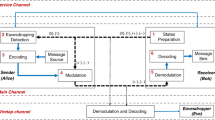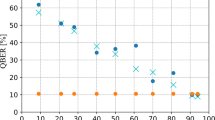Abstract
Quantum secure direct communication (QSDC) that allows people to directly transmit confidential information through insecure channels is an important branch of quantum communication. The widespread adoption of the QSDC demands the development of simple and stable systems. However, most of the existent QSDC systems involve a complex self-alignment process at the initial stage and additional hardware to compensate environmental disturbance. In this study, we present a fiber-based QSDC system without active polarization compensation. Our system comprises a stable transmitter and a novel Sagnac-Mach-Zehnder interferometer for security detection. This robust system simplifies the self-alignment and is immune to environmental disturbance. The robustness of the system was theoretically and experimentally verified, and low bit error rates in a 12 min continuous operation with an active polarization scrambler were attained. In addition, we performed a proof-of-principle QSDC demonstration, and a secrecy capacity of 3.43 kbps over a 5 km fiber with a detection bit error rate of 0.85% ± 0.07% and a quantum bit error rate of 0.42% ± 0.05% were achieved. Experimental results confirm the viability of the proposed QSDC system for practical applications.
Similar content being viewed by others
References
P. Shor, in Algorithms for quantum computation: Discrete logarithms and factoring: Proceedings of the 35th Annual Symposium on Foundations of Computer Science, Santa Fe, 2002. 124–134.
L. K. Grover, in A fast quantum mechanical algorithm for database search: Proceedings of the 28th Annual ACM Symposium on Theory of Computing, Philadelphia, 1996. 212–219.
G. L. Long, and X. S. Liu, Phys. Rev. A 65, 032302 (2002), arXiv: quant-ph/0012056.
C. Wang, Fundamental Res. 1, 91 (2021).
J. Wu, Z. Lin, L. Yin, and G. L. Long, Quantum Eng. 1, e26 (2019).
F. G. Deng, G. L. Long, and X. S. Liu, Phys. Rev. A 68, 042317 (2003), arXiv: quant-ph/0308173.
F. G. Deng, and G. L. Long, Phys. Rev. A 69, 052319 (2004), arXiv: quant-ph/0405177.
S. S. Chen, L. Zhou, W. Zhong, and Y. B. Sheng, Sci. China-Phys. Mech. Astron. 61, 090312 (2018).
L. Yang, J. W. Wu, Z. S. Lin, L. G. Yin, and G. L. Long, Sci. China-Phys. Mech. Astron. 63, 110311 (2020).
S. H. Sun, and G. L. Long, Quantum Eng. 3, e86 (2021).
X. Liu, Z. Li, D. Luo, C. Huang, D. Ma, M. Geng, J. Wang, Z. Zhang, and K. Wei, Sci. China-Phys. Mech. Astron. 64, 120311 (2021).
X. T. Feng, J. Y. Song, and C. Wang, Int. J. Quantum Inform. 20, 2250010 (2022).
J. Wu, G. L. Long, and M. Hayashi, Phys. Rev. Appl. 17, 064011 (2022), arXiv: 2112.15113.
G. L. Long, and H. Zhang, Sci. Bull. 66, 1267 (2021).
Z. Sun, L. Song, Q. Huang, L. Yin, G. Long, J. Lu, and L. Hanzo, IEEE Trans. Commun. 68, 5778 (2020).
Z. R. Zhou, Y. B. Sheng, P. H. Niu, L. G. Yin, G. L. Long, and L. Hanzo, Sci. China-Phys. Mech. Astron. 63, 230362 (2020), arXiv: 1805.07228.
P. H. Niu, Z. R. Zhou, Z. S. Lin, Y. B. Sheng, L. G. Yin, and G. L. Long, Sci. Bull. 63, 1345 (2018).
Z. Gao, T. Li, and Z. Li, Europhys. Lett. 125, 40004 (2019).
L. Zhou, Y. B. Sheng, and G. L. Long, Sci. Bull. 65, 12 (2020).
L. Zhou, and Y.-B. Sheng, Sci. China-Phys. Mech. Astron. 65, 250311 (2022).
F. G. Deng, H. Y. Zhou, and G. L. Long, J. Phys. A-Math. Gen. 39, 14089 (2006), arXiv: quant-ph/0612018.
F. G. Deng, X. H. Li, C. Y. Li, P. Zhou, and H. Y. Zhou, Chin. Phys. 16, 3553 (2007), arXiv: quant-ph/0606008.
Z. Qi, Y. Li, Y. Huang, J. Feng, Y. Zheng, and X. Chen, Light Sci. Appl. 10, 183 (2021), arXiv: 2106.13509.
J. H. Shapiro, Z. Zhang, and F. N. C. Wong, Quantum Inf. Process. 13, 2171 (2014).
F. Del Santo, and B. Dakić, Phys. Rev. Lett. 120, 060503 (2018), arXiv: 1706.08144.
F. Massa, A. Moqanaki, A. Baumeler, F. Del Santo, J. A. Kettlewell, B. Dakić, and P. Walther, Adv. Quantum Tech. 2, 1900050 (2019).
J. H. Shapiro, D. M. Boroson, P. B. Dixon, M. E. Grein, and S. A. Hamilton, J. Opt. Soc. Am. B 36, B41 (2019).
Y. B. Sheng, L. Zhou, and G. L. Long, Sci. Bull. 67, 367 (2022).
C. Y. Gao, P. L. Guo, and B. C. Ren, Quantum Eng. 3, e83 (2021).
Z. Huang, Z. Rong, X. Zou, and Z. He, Quantum Inf. Process. 20, 375 (2021).
Z. Rong, D. Qiu, P. Mateus, and X. Zou, Quantum Inf. Process. 20, 58 (2021).
S. Srikara, K. Thapliyal, and A. Pathak, Quantum Inf. Process. 19, 132 (2020), arXiv: 1909.09697.
Z. Cao, L. Wang, K. Liang, G. Chai, and J. Peng, Phys. Rev. Appl. 16, 024012 (2021).
J. Y. Hu, B. Yu, M. Y. Jing, L. T. Xiao, S. T. Jia, G. Q. Qin, and G. L. Long, Light Sci. Appl. 5, e16144 (2016), arXiv: 1503.00451.
F. Zhu, W. Zhang, Y. Sheng, and Y. Huang, Sci. Bull. 62, 1519 (2017), arXiv: 1710.07951.
W. Zhang, D. S. Ding, Y. B. Sheng, L. Zhou, B. S. Shi, and G. C. Guo, Phys. Rev. Lett. 118, 220501 (2017), arXiv: 1609.09184.
R. Qi, Z. Sun, Z. Lin, P. Niu, W. Hao, L. Song, Q. Huang, J. Gao, L. Yin, and G. L. Long, Light Sci. Appl. 8, 22 (2019), arXiv: 1810.11806.
D. Pan, Z. Lin, J. Wu, H. Zhang, Z. Sun, D. Ruan, L. Yin, and G. L. Long, Photon. Res. 8, 1522 (2020).
H. Zhang, Z. Sun, R. Qi, L. Yin, G. L. Long, and J. Lu, Light Sci. Appl. 11, 83 (2022).
A. Muller, T. Herzog, B. Huttner, W. Tittel, H. Zbinden, and N. Gisin, Appl. Phys. Lett. 70, 793 (1997), arXiv: quant-ph/9611042.
S. H. Sun, H. Q. Ma, J. J. Han, L. M. Liang, and C. Z. Li, Opt. Lett. 35, 1203 (2010).
H. Q. Ma, K. J. Wei, and J. H. Yang, Opt. Lett. 38, 4494 (2013).
K. J. Wei, H. Q. Ma, and J. H. Yang, Opt. Express 21, 16663 (2013).
Z. Chen, L. Yin, Y. Pei, and J. Lu, Sci. China Inf. Sci. 59, 102309 (2016).
P. Wang, L. Yin, and J. Lu, Tsinghua Sci. Tech. 23, 323 (2018).
Q. Huang, and S. Yuan, IEEE Trans. Commun. 64, 38 (2016).
J. Wen, S. Li, X. Liu, C.-F. Huang, J.-W. Wang, T. Shi, and K.-J. Wei, J. Guangxi Univ. (Nat. Sci. Ed.) 47, 723 (2022).
X. T. Song, D. Wang, X. M. Lu, D. J. Huang, D. Jiang, L. X. Li, X. Fang, Y. B. Zhao, and L. J. Zhou, Phys. Rev. A 101, 032319 (2020).
S. Wang, W. Chen, Z. Q. Yin, D. Y. He, C. Hui, P. L. Hao, G. J. Fan-Yuan, C. Wang, L. J. Zhang, J. Kuang, S. F. Liu, Z. Zhou, Y. G. Wang, G. C. Guo, and Z. F. Han, Opt. Lett. 43, 2030 (2018), arXiv: 1805.09952.
Author information
Authors and Affiliations
Corresponding author
Additional information
This study was supported by the National Natural Science Foundation of China (Grant Nos. 62171144, and 11905065), Guangxi Science Foundation (Grant Nos. 2021GXNSFAA220011, and 2021AC19384), Open Fund of IPOC (BUPT) (Grant No. IPOC2021A02), and Innovation Project of Guangxi Graduate Education (Grant No. YCSW2022040). We thank D. Ma for helpful discussions.
Rights and permissions
About this article
Cite this article
Liu, X., Luo, D., Lin, G. et al. Fiber-based quantum secure direct communication without active polarization compensation. Sci. China Phys. Mech. Astron. 65, 120311 (2022). https://doi.org/10.1007/s11433-022-1976-0
Received:
Accepted:
Published:
DOI: https://doi.org/10.1007/s11433-022-1976-0




